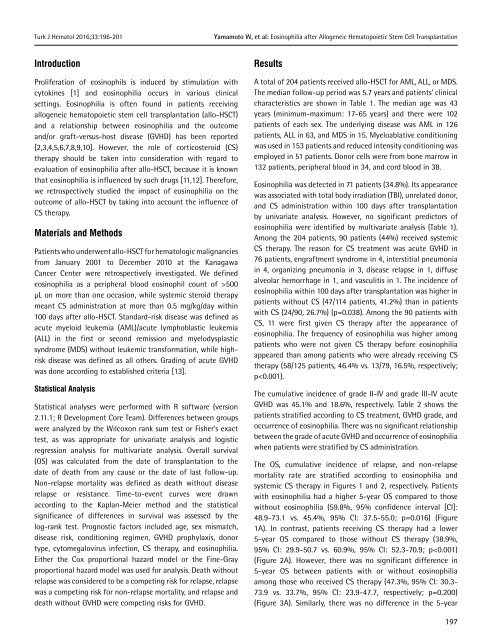Turkish Journal of Hematology Volume: 33 - Issue: 3
Create successful ePaper yourself
Turn your PDF publications into a flip-book with our unique Google optimized e-Paper software.
Turk J Hematol 2016;<strong>33</strong>:196-201<br />
Yamamoto W, et al: Eosinophilia after Allogeneic Hematopoietic Stem Cell Transplantation<br />
Introduction<br />
Results<br />
Proliferation <strong>of</strong> eosinophils is induced by stimulation with<br />
cytokines [1] and eosinophilia occurs in various clinical<br />
settings. Eosinophilia is <strong>of</strong>ten found in patients receiving<br />
allogeneic hematopoietic stem cell transplantation (allo-HSCT)<br />
and a relationship between eosinophilia and the outcome<br />
and/or graft-versus-host disease (GVHD) has been reported<br />
[2,3,4,5,6,7,8,9,10]. However, the role <strong>of</strong> corticosteroid (CS)<br />
therapy should be taken into consideration with regard to<br />
evaluation <strong>of</strong> eosinophilia after allo-HSCT, because it is known<br />
that eosinophilia is influenced by such drugs [11,12]. Therefore,<br />
we retrospectively studied the impact <strong>of</strong> eosinophilia on the<br />
outcome <strong>of</strong> allo-HSCT by taking into account the influence <strong>of</strong><br />
CS therapy.<br />
Materials and Methods<br />
Patients who underwent allo-HSCT for hematologic malignancies<br />
from January 2001 to December 2010 at the Kanagawa<br />
Cancer Center were retrospectively investigated. We defined<br />
eosinophilia as a peripheral blood eosinophil count <strong>of</strong> >500<br />
µL on more than one occasion, while systemic steroid therapy<br />
meant CS administration at more than 0.5 mg/kg/day within<br />
100 days after allo-HSCT. Standard-risk disease was defined as<br />
acute myeloid leukemia (AML)/acute lymphoblastic leukemia<br />
(ALL) in the first or second remission and myelodysplastic<br />
syndrome (MDS) without leukemic transformation, while highrisk<br />
disease was defined as all others. Grading <strong>of</strong> acute GVHD<br />
was done according to established criteria [13].<br />
Statistical Analysis<br />
Statistical analyses were performed with R s<strong>of</strong>tware (version<br />
2.11.1; R Development Core Team). Differences between groups<br />
were analyzed by the Wilcoxon rank sum test or Fisher’s exact<br />
test, as was appropriate for univariate analysis and logistic<br />
regression analysis for multivariate analysis. Overall survival<br />
(OS) was calculated from the date <strong>of</strong> transplantation to the<br />
date <strong>of</strong> death from any cause or the date <strong>of</strong> last follow-up.<br />
Non-relapse mortality was defined as death without disease<br />
relapse or resistance. Time-to-event curves were drawn<br />
according to the Kaplan-Meier method and the statistical<br />
significance <strong>of</strong> differences in survival was assessed by the<br />
log-rank test. Prognostic factors included age, sex mismatch,<br />
disease risk, conditioning regimen, GVHD prophylaxis, donor<br />
type, cytomegalovirus infection, CS therapy, and eosinophilia.<br />
Either the Cox proportional hazard model or the Fine-Gray<br />
proportional hazard model was used for analysis. Death without<br />
relapse was considered to be a competing risk for relapse, relapse<br />
was a competing risk for non-relapse mortality, and relapse and<br />
death without GVHD were competing risks for GVHD.<br />
A total <strong>of</strong> 204 patients received allo-HSCT for AML, ALL, or MDS.<br />
The median follow-up period was 5.7 years and patients’ clinical<br />
characteristics are shown in Table 1. The median age was 43<br />
years (minimum-maximum: 17-65 years) and there were 102<br />
patients <strong>of</strong> each sex. The underlying disease was AML in 126<br />
patients, ALL in 63, and MDS in 15. Myeloablative conditioning<br />
was used in 153 patients and reduced intensity conditioning was<br />
employed in 51 patients. Donor cells were from bone marrow in<br />
132 patients, peripheral blood in 34, and cord blood in 38.<br />
Eosinophilia was detected in 71 patients (34.8%). Its appearance<br />
was associated with total body irradiation (TBI), unrelated donor,<br />
and CS administration within 100 days after transplantation<br />
by univariate analysis. However, no significant predictors <strong>of</strong><br />
eosinophilia were identified by multivariate analysis (Table 1).<br />
Among the 204 patients, 90 patients (44%) received systemic<br />
CS therapy. The reason for CS treatment was acute GVHD in<br />
76 patients, engraftment syndrome in 4, interstitial pneumonia<br />
in 4, organizing pneumonia in 3, disease relapse in 1, diffuse<br />
alveolar hemorrhage in 1, and vasculitis in 1. The incidence <strong>of</strong><br />
eosinophilia within 100 days after transplantation was higher in<br />
patients without CS (47/114 patients, 41.2%) than in patients<br />
with CS (24/90, 26.7%) (p=0.038). Among the 90 patients with<br />
CS, 11 were first given CS therapy after the appearance <strong>of</strong><br />
eosinophilia. The frequency <strong>of</strong> eosinophilia was higher among<br />
patients who were not given CS therapy before eosinophilia<br />
appeared than among patients who were already receiving CS<br />
therapy (58/125 patients, 46.4% vs. 13/79, 16.5%, respectively;<br />
p

















